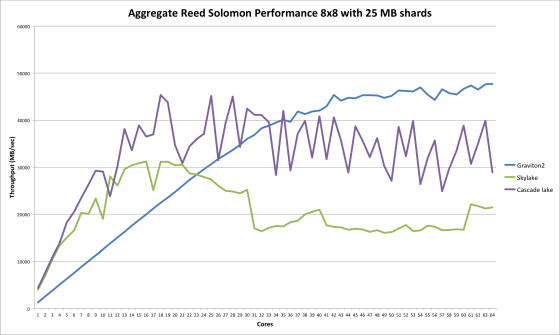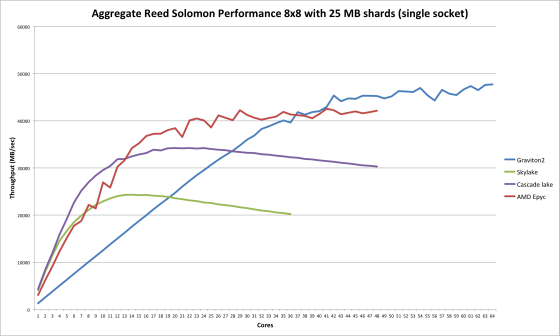How close is the performance of the Amazon-designed ARM processor 'Graviton 2' to Intel CPUs?

The Amazon-designed ARM processor '
Intel + ARM Performance Characteristics for S3 Compatible Object Storage
https://blog.min.io/intel_vs_gravitron/
MinIO is an AWS S3-compatible online storage that is Apache license compliant. MinIO is developed by Go to maintain high performance. Wessels says the computationally expensive algorithms that MinIO uses are erasure correction , hashing, and encryption.
This time Wessels benchmarked the c5.18xlarge instance that uses the Skylake generation CPU among the AWS EC2 instances and the m6g.16large instance that adopted Graviton 2, and the detailed specifications are as follows. ..
| Instance name | c5.18xlarge | m6g.16large |
|---|---|---|
| Architecture | x86_64 | aarch64 |
| CPU(s) | 72 | 64 |
| Thread(s) per core | 2 | 1 |
| Core(s) per socket | 18 | 64 |
| Socket(s) | 2 | 1 |
| NUMA node(s) | 2 | 1 |
| L1d cache | 32K | 64K |
| L1i cache | 32K | 64K |
| L2 cache | 1024K | 1024K |
| L3 cache | 25344K | 32768K |
First, in order to compare the performance of erasure correction, when performing erasure correction of Reed-Solomon code with a data size of 1 MB to 25 MB, the green core Skylake leads in the single core performance shown in the left graph. However, in Skylake, performance declines as the data size increases, whereas in Blue Graviton 2 it is almost flat. Also, in terms of multi-core performance, Graviton 2 physically equipped with 64 cores is superior, and the difference opens as the data size increases.

Also in the hash calculation, the result is that Skylake beats single core and Graviton 2 wins multicore.

A similar trend can be seen in AES encryption benchmarks.

The graph below shows the results of testing how the performance of erasure correction changes with the scale of the core with Skylake, Cascade lake, Graviton 2. Green Skylake is superior to Graviton 2 until the number of cores is around 22, but after that, the improvement in performance has peaked even if the number of cores is increased, whereas the blue Graviton 2 is completely up to around 32 cores. The performance is improved according to the linear shape. Similar to Skylake, the purple Cascade lake is faster than Graviton 2 with a small number of cores, but it has a result that it can not match Graviton 2 with a certain number of cores.

Wessels decided to measure the performance of erasure correction by narrowing the socket used to one in order to further match the conditions of the comparison target. In this benchmark, AMD's 'EPYC 7R32' provided by c5a instance is also included in the measurement target. As a result, it is not much different from the previous graph, but Wessels says that it is a more “smooth” graph. While Intel CPUs with a small number of physical cores in one socket are at their peak, Graviton 2, which can use 64 cores, does not show a drop in performance.

In addition, EPYC achieves better scale-up than Intel CPU, but in the high-end area Graviton 2 is one step behind. The graph immediately above shows 'dual socket servers are competing for memory access, which has a significant performance impact,' Wessels said.
Below is a table summarizing the usage charge and power consumption of each instance. You can see that m6g.16large which is an instance that adopts Graviton 2 is superior to other instances in both usage charge and power consumption.

Also, regarding the power consumption and usage fee per unit, it looks like this when the number of vCPUs and the number of physical cores are calculated as a unit. Mr. Wessels commented that the reason for showing this table is 'the effectiveness of hyper-threading greatly changes depending on the case to use'.

With the introduction of Graviton 2 by AWS, ARM processors are not only narrowing the gap with Intel's CPUs, but even exceeding multi-core Intel, Wessels points out. In addition, Mr. Wessels also talked about Ampere, which is developing an ARM processor for servers as Amazon, and commented that Amazon is not the only one paying attention to ARM.
Related Posts:
in Hardware, Posted by darkhorse_log







